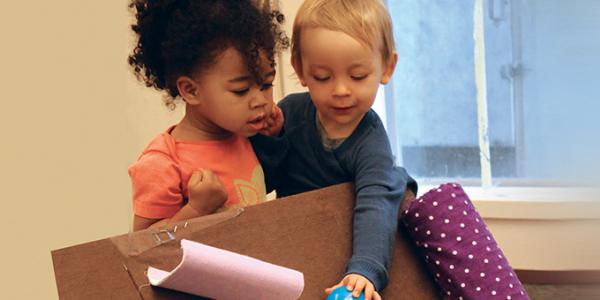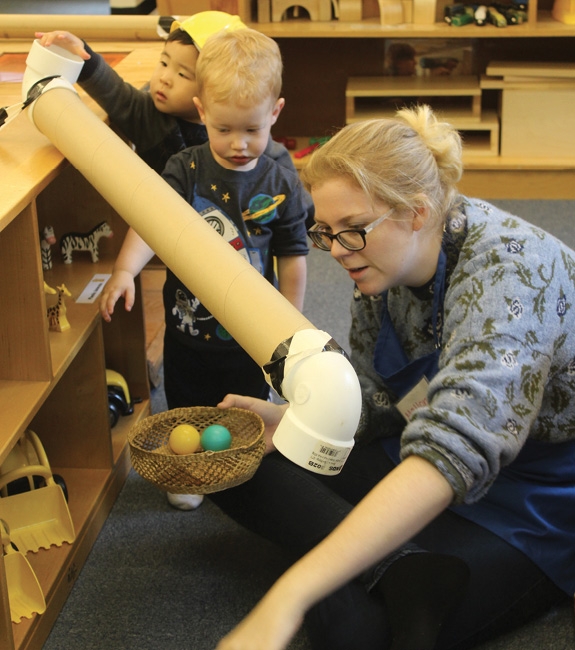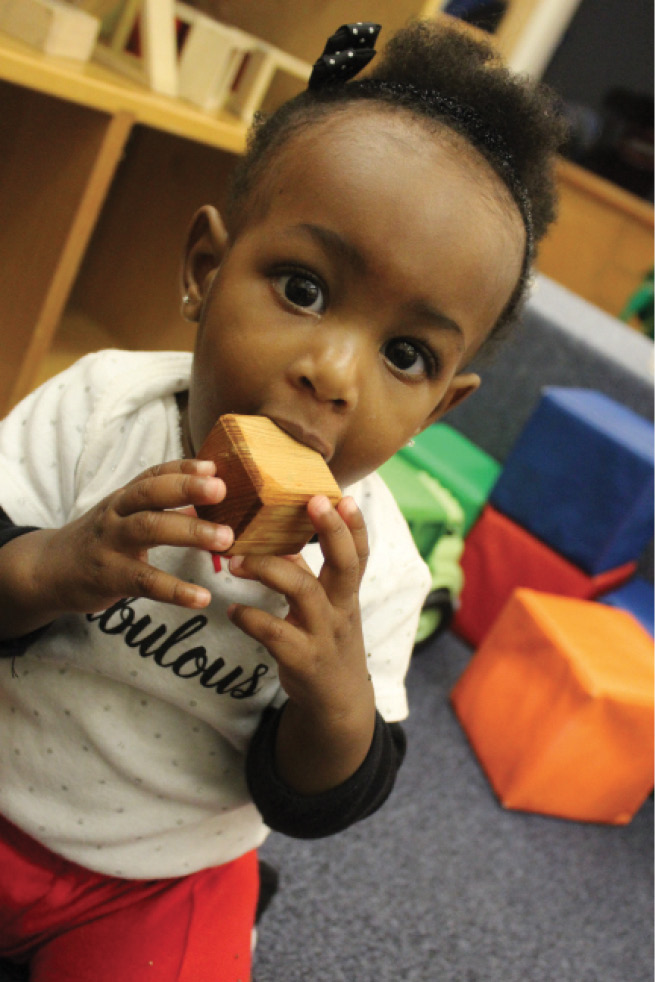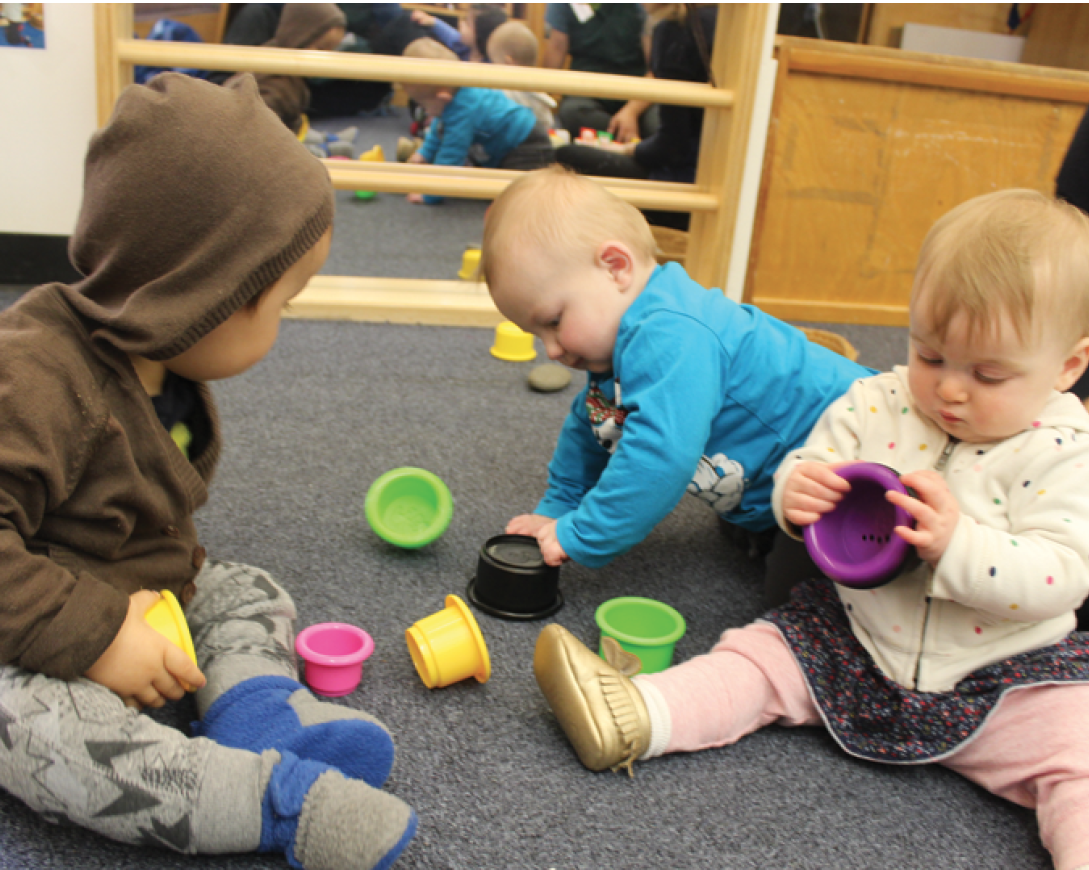Mathematizing with Toddlers and Coaching Undergraduates: Foundations for Intentional Math Development

You are here
Kamiah, 24 months, stands at a ramp in the toddler room, gripping a baseball-size ball. She rolls it down a wooden ramp (that is shaped like a gutter), tracking it until it drops into a basket. She rushes over to the bin of balls nearby, uses both hands to grip a much larger ball, and places it on the same ramp. The ball, too wide for the ramp’s edges, rolls for a moment, then tips off the side, falling to the carpet. Kamiah wrinkles her forehead, tracking the ball, then returns to the bin and finds another baseball-size ball. She smiles and her shoulders relax as this ball rolls down the ramp and falls into the basket. Kamiah repeats this over and over, using all of the balls in the basket several times. She stares wide-eyed as a bumpy ball bumps off of the ramp, and giggles as the smallest ball zips right down the middle.
While it may seem like Kamiah is simply playing, she is doing much more. She is mathematizing: looking at the balls’ attributes, such as size and texture, examining their similarities and differences, and discovering patterns (in small ramps, small balls roll better than large ones). A skilled teacher could accomplish a great deal with this teachable moment by narrating Kamiah’s explorations and posing open-ended questions.

Undergraduate student and children explore plastic rain-gutter and PVC pipe/cardboard tubing in the block area.
As the coordinator for the infant and toddler programs at the Early Childhood Laboratory School at UC Davis, I work closely with two lead teachers to create the curriculum for the youngest learners, and to craft parallel learning experiences for undergraduates in teacher preparation. Our infant and toddler classrooms are intellectually rich spaces where children and adults discover new challenges that match their interests.
Based on an assessment designed to identify areas for growth, the lead teachers and I determined that the undergraduates needed a clearer understanding of how to scaffold open-ended thinking with the toddlers. Such scaffolding is closely aligned with the development of mathematical thought. So, throughout the past school year, my challenge was mathematizing the toddler classroom, including helping the undergraduates engage in mathematical talk with the children and ask questions that inspire mathematical thinking. (I also extended this work into the infant classroom, as discussed in “Mathematizing with Infants,” below.)
My colleagues and I knew that the richness of math language to which children are exposed is correlated with future school success (Eason & Levine 2017), but we were not sure how to intentionally cultivate more enriching math talk among the undergraduates. Seeking guidance, I read Allen Rosales’s book Mathematizing: An Emergent Math Curriculum Approach for Young Children (2015). His description of labeling, sportscasting (in which teachers narrate the mathematical aspects of children’s activities), and asking open-ended questions seemed ideal for the toddlers as well as the undergraduates.
Mathematizing as a mindset
Toddlers are not short kindergartners; surrounding them with number words is not the same as teaching them what a number concept means, just as pushing them to memorize is not fostering understanding. In the first few years of life, children learn the basic language of math—more, all—in order to explore more advanced concepts—one, two (California DEd 2015).
To immerse young children in rich math language, Rosales (2015) recommends that teachers approach mathematizing as a mindset, a way of teaching that is mindful of math words, concepts, and ways of questioning. The key to mathematics with toddlers (and infants) is sportscasting—talking aloud using self-talk, parallel talk, and reflective speech—to highlight math concepts (Greenburg 2012; Early Head Start 2018).
In preparing to add math language to their classrooms, teachers should think broadly about mathematics. In addition to numbers, teachers should talk—and help children think—about measurement, patterns, change, and sorting (Greenburg 2012). These examples model how to sportscast math concepts for very young children:
- Numbers: “I have three crackers and you have three crackers. Let’s each eat one. Now we each have two! Do you want more?”
- Measurement: “You had a long nap today!” “That’s a heavy pumpkin.”
- Patterns: “You are wearing stripes! Red, blue, red, blue!” “Let’s drum to the beat of the song together.”
- Change: “I think the beets in the garden grew bigger!” “Your diaper was wet—this one is dry.”
- Sorting: “You put all the necklaces on your hand and all the bracelets on your wrist!” “You put the baby with the bottle!”
Similarly, the Erikson Institute (2018) recommends focusing on four key concepts that infants and toddlers need to master as a foundation for developing mathematical knowledge and skills in preschool and beyond. These concepts are interrelated and build on each other. They begin with awareness of the attributes of things, which allows children to engage in making comparisons, leading to observations of changes, and through this, recognition of predictable patterns. To help children develop these abilities, teachers must speak the language of math, being aware of basic word choices and gradually shifting to more complex choices and questions in tandem with the children’s development.
Labeling, sportscasting, and questioning
For the toddler classroom, I created posters of math words to support the teachers and undergraduates in using mathematical language. Drawing primarily from Rosales (2015), the words I selected for the classroom posters included: more, all gone, numbers one to 10, all together, big, little, full, empty, hot, cold, heavy, light, circle, square, in, out, under, around, up, down, again, behind, in front of, another, curve, edge, side, line, corner, straight, and flat (see also Eason and Levine 2017).
I also invited our staff and undergraduates to move into complex open-ended questioning, not simply asking informational questions or scaffolding, but asking “I wonder” questions. While introducing this to the undergraduates, I encouraged them to engage in wondering without shepherding children toward the “right” answer, knowing that children learn as much from trial and error as from their successes (just as the undergraduates do).
In the first few years of life, children learn the basic language of math—more, all—in order to explore more advanced concepts—one, two.
That simple introduction was far from sufficient. Soon after we began mathematizing the toddler room, I discovered that the undergraduates were struggling to engage the children through questioning. They repeatedly fell into the trap of grilling the children with multiple direct questions. Getting the undergraduates to highlight mathematical attributes—using focused language such as more, big, and heavy—was easy, but clarifying the line between dragging a child to the right answer and inviting open-ended mathematical thought was a long-term challenge.
To support the undergraduates’ growth, and ensure that the toddlers were experiencing math language and concepts, I decided to emphasize labeling and sportscasting. I asked the undergraduates to narrate what the children were doing and what they themselves were doing, being sure to include the conceptual language regarding attributes, comparisons, changes, and patterns (Erikson 2017). The undergraduates were soon using nouns such as cup and shape, adjectives like bumpy and red, and verbs such as growing and repeating.
In the second quarter of the school year, I returned to working with the undergraduates on open-ended questions and scaffolding, particularly when children were struggling with problem solving. The lead teacher and I coached the undergraduates, and we created charts with examples of open-ended questions based on Rosales (2015). Having practiced math sportscasting, their questioning improved. Still, they mostly used math language when prompted—not frequently, consistently, or spontaneously enough to give the toddlers sufficient opportunities to grasp mathematical ideas.
Creating a supportive environment
To cue intentional math talk, the classroom must be intentionally designed to foster mathematical activities and thinking. For toddlers, the environment should not be set up to focus on adult-led outcome-based activity; it should invite children’s casual exploration and deeper, weeks-long investigation, with teachers as learning partners rather than experts.
The lead toddler teacher and I began mathematizing the classroom by placing tubes and ramps in the block area. Having a display of tubes and ramps (which were a passion of this group of children when they were in our infant room) invited the undergraduates and toddlers to engage in play. Through play, they had conversations about change (a longer tube is created when two tubes are joined) as well as size, shape, and other attributes of objects that could roll or slide through the tubes. They also made comparisons (some objects will fit in the tube and some will not, regardless of their color or material) and discovered patterns (each object rolls or slides the same way unless the toddler makes a change).
The lead teacher and I looked at many mathematical concepts, such as volume and size, and presented instructional designs that invited the undergraduates to sportscast. With our support, the undergraduates narrated about the color, weight, and shape of the balls or vehicles, and counted them as they rolled past us, modeling the use of math language for the toddlers. Since we had posted a math chart nearby, the undergraduates could peek at it to find the key words they needed: “The ball went down. You rolled another one down after it. Now the basket looks full. I wonder if it can fit any more.” (This combination of materials and related charts provided environmental cues that would be likely to work in other settings with classroom volunteers, though coaching and training would probably be necessary. Resources such as “Help Your Child Develop Early Math Skills” from Zero to Three [2016] would be strong background reading for parent volunteers.)
The lead teacher and I also kept our eyes peeled for child-led explorations of the same concept (or attribute) in other areas, such as toddlers sliding (themselves or selected objects) down the ramp in the dramatic play area, sliding down the slides in the yard, and creating ramps out of big blocks. We were looking for toddler intentionality, especially when they were investigating directly by, for example, rolling different items down the slide one by one, or shifting their feet or bodies to slow or speed their own path down the slide.
Mathematizing with Infants
Zia, who is 12 months, sits in the ball pit in the infant room pressing an orange-size plastic ball to her mouth. She turns it, drops it, reaches down, and lifts another ball to her mouth, this one larger and with a bumpy surface. She mouths the bumpy ball, then drops this too, now grasping a fabric ball that she again lifts to her mouth. Zia, eagerly exploring the attributes of different balls, is engaged in a mathematical investigation—and would benefit from a well-prepared teacher narrating (with parallel talk) the math-related concepts she is experiencing.
 In the infant room, each area needs to invite exploration for sensory learners. To mathematize our infant classroom, the lead teacher and I provided a range of sensory materials that are safe for mouthing. In the dramatic play area, for example, we offered colorful plastic fruit, different colored plates, metal mixing bowls in a range of sizes, two types of spoons (some large and wooden, some smaller and plastic), many sizes and shades of plastic baby dolls (some in cloth diapers, some in disposable ones), and many books about babies exploring food or kitchen supplies. Designing the area in this way invites the use of mathematical attribute-based language and comparisons, such as, “You have a big brown spoon and a little yellow spoon. The brown spoon is bigger!”
In the infant room, each area needs to invite exploration for sensory learners. To mathematize our infant classroom, the lead teacher and I provided a range of sensory materials that are safe for mouthing. In the dramatic play area, for example, we offered colorful plastic fruit, different colored plates, metal mixing bowls in a range of sizes, two types of spoons (some large and wooden, some smaller and plastic), many sizes and shades of plastic baby dolls (some in cloth diapers, some in disposable ones), and many books about babies exploring food or kitchen supplies. Designing the area in this way invites the use of mathematical attribute-based language and comparisons, such as, “You have a big brown spoon and a little yellow spoon. The brown spoon is bigger!”
We found that incorporating mathematical language about change and pattern was easiest during care routines. For example, “Trudi is cleaning the tables and then we will have snack; we wash our hands before snack,” and, “Your cracker is all gone. Do you want more?”
One of the biggest challenges to mathematizing the infants’ experience was maintaining math thinking as a priority in the classroom. Particularly with the undergraduates, I discovered that in the week I targeted the skill of math talk, everyone leapt to the challenge, trying on the math vocabulary and engaging the children in investigations. The next week, however, there was a much less pronounced effect. Through continued practice and environmental prompts (such as math materials and charts with reminders), the undergraduates’ use of math language became more frequent. For infant educators, math talk needs to become a natural, everyday part of how they use parallel talk and self-talk.
The Erikson Institute (2017) emphasizes that mathematics is a language for precise thinking. For infants, the long road to precise thinking begins with grasping the mathematical precursors (which are explained in the main article; see Erikson 2018). Once we give infants and toddlers the language for articulating the attributes of things they see, we can help them notice how things compare and how they change, and then become aware of patterns. Soon, they will be well on their way to developing a meaningful concept of number.
Maximizing learning
We hunted for children’s interest in exploring math concepts because when people actively investigate a topic, they are more open to wondering with you about the topic, and more excited about finding different ways to think about it. When we saw intentional play in which a toddler seemed to be experimenting with math, the lead teacher and I scaffolded the child’s direct learning. We did this by sportscasting the action using parallel talk and then asking open-ended questions: “I see you lifting and dropping your feet as you go down the slide. I wonder if you go slower when you put your feet down.” The goal was to help the toddlers focus more deeply on their chosen investigations (Rosales 2015).
We modeled this technique for the undergraduates but did not expect them to consistently perceive teachable moments. The ability to recognize and expand on teachable moments comes with practice.
We knew, however, that there were many moments that undergraduates would notice, such as when the toddlers started to become frustrated by a problem they were trying to solve. When children struggled with an activity, like rolling balls up a ramp, the lead teacher and I asked the undergraduates to use the phrase “I wonder” to suggest an option instead of giving the toddler a solution. For example, the undergraduate might say, “It looks like you are trying to roll the ball up the ramp. I wonder what would happen if you put the ball here, instead, and let it go.”
For toddlers, the environment should invite children's casual exploration and deeper, weeks-long investigation.
Rosales (2015) also suggests the technique of “focusing” statements, which are used to facilitate but not take over learning. The teacher follows the child’s thinking, observes, and then comments on actions. For example, “I wonder which blocks you will use next.” “I wonder why the blocks keep falling.” “I wonder how many blocks you will put in the center of your tower.” This type of remark is mainly a statement of curiosity; unlike a direct question, it allows children to wonder without answering and does not seek or provide a right answer from the teacher.
Videos to Support Mathematizing
Using video examples helped our undergraduates understand the foundational concepts and te rms outlined in Rosales’s (2015) book and in the work by the Erikson Institute (2018). After seeing the undergraduates’ early struggles—especially with open-ended questioning—I was relieved to find that several videos enabled them to seize “teachable moments.” The following videos also support sportscasting to highlight the ideas central to mathematical thinking (Sarama & DiBiase 2004).
rms outlined in Rosales’s (2015) book and in the work by the Erikson Institute (2018). After seeing the undergraduates’ early struggles—especially with open-ended questioning—I was relieved to find that several videos enabled them to seize “teachable moments.” The following videos also support sportscasting to highlight the ideas central to mathematical thinking (Sarama & DiBiase 2004).
Erikson Institute
-
Early Exploration of Attributes with an Avocado
http://earlymath.erikson.edu/early-exploration-attributes-avocado-concep...
-
Developing Ideas of Attribute While Reading to Babies
http://earlymath.erikson.edu/developing-ideas-attribute-reading-to-babies/
Zero to Three
-
Let’s Talk About Math: Early Math Video Series
www.zerotothree.org/resources/series/let-s-talk-about-math-early-math-vi...
Conclusion
Through this focus on mathematizing, the teachers, undergraduates, and I were able to explore mathematics in a deeper and more satisfying way. Because we engaged in sportscasting across subjects and topics everyday, applying the practice to math concepts was especially helpful as the undergraduates became more comfortable thinking, talking, and questioning in mathematical terms.
I found personal joy in this mathematical journey by seeing toddlers’ joy as they tested how many blocks they could stack before the inevitable collapse.
I also found personal joy in this mathematical journey. As I shifted away from worrying about math as a set of right and wrong textbook answers, I began to see how delighted the infants felt as they explored volume by putting themselves in all kinds of containers, and the joy that the toddlers showed as they tested how many blocks they could stack before the inevitable collapse.
I became more willing and able to join my daughter in her own mathematizing journey. Sitting together on the floor of our living room and counting the dots on dominoes to find out how many different combinations of dots equal 12 would not have occurred to me before this investigation started. A year later, there I sat, the former mathematical failure, researching a mathematical question in my free time and delighting in my daughter’s love of mathematics.
A Personal Journey
While the needs of the children and undergraduates were my primary concern, I also had personal reasons for focusing on mathematizing. It is an understatement to say that I did not like math in elementary school. My primary memories of math learning involve being unable to recall flash-card facts, timed testing, failure, and being the only one in the fifth grade with no achievement star on the classroom math wall. The feeling that I was completely incapable of learning math lurked throughout the rest of my school career, at my side in every math class—impacting my interest in teaching others about math.
I was not alone in this feeling. Many early childhood educators feel anxious about teaching math and avoid the subject when possible (Ginsburg, Lee, & Boyd 2008; Beilock et al. 2010; Fuson, Clements, & Beckmann 2010). But I was aware that young children’s mathematical performance relies on their teachers’ capability in math (Sarama & DiBiase 2004), and I needed to be willing to expand my skill in this area.
In undertaking my mathematizing challenge, I planned to reexamine my attitude toward math—maybe even find joy in the subject. I had the added inspiration of my own 4-year-old daughter, who passionately loves mathematizing.
References
Beilock, S.L., E.A. Gunderson, G. Ramirez, & S.C. Levine. 2010. “Female Teachers’ Math Anxiety Affects Girls’ Math Achievement.” Proceedings of the National Academy of Sciences. 107 (5): 1860–63. www.pnas.org/content/107/5/1860.
California Department of Education. 2015. “Desired Results Developmental Profile: A Developmental Continuum from Early Infancy to Kindergarten Entry—Infant/Toddler View.” Sacramento: California Department of Education. www.cde.ca.gov/sp/cd/ci/documents/drdp2015infanttoddler.pdf.
Early Head Start. 2018. “Supporting Early Math Learning for Infants and Toddlers.” School Readiness: News You Can Use. https://eclkc.ohs.acf.hhs.gov/school-readiness/article/news-you-can-use-....
Eason, S.H., & S.C. Levine. 2017. “Math Learning Begins at Home.” ZERO TO THREE. 37 (5): 35–43.
Erikson Institute Early Math Collaborative. 2017. “What Is Early Math?” http://earlymath.erikson.edu/about-early-math-programming-for-teachers-a....
Erikson Institute Early Math Collaborative. 2018. “Precursor Topics.” http://earlymath.erikson.edu/precursor-topics/.
Fuson, K.C., D.H. Clements, & S. Beckmann, eds. 2010. Focus in Prekindergarten: Teaching with Curriculum Focal Points. Reston, VA: NCTM (National Council of Teachers of Mathematics) & Washington, DC: NAEYC (National Association for the Education of Young Children).
Ginsburg, H.P., J.S. Lee, & J.S. Boyd. 2008. “Mathematics Education for Young Children: What It Is and How to Promote It.” Social Policy Report. Society for Research in Child Development 22 (1).
Greenburg, J. 2012. “More, All Gone, Empty, Full: Math Talk Every Day in Every Way.” Rocking and Rolling. Young Children 67 (3): 62–64. www.naeyc.org/sites/default/files/globally-shared/Images/resources/pubs/....
Sarama, J., & A.-M. DiBiase. 2004. “The Professional Development Challenge in Preschool Mathematics.” In Engaging Young Children in Mathematics: Standards for Early Childhood Mathematics Education, eds., D.H. Clements, J. Sarama, & A.-M. DiBiase, 415–46. Mahwah, NJ: Erlbaum.
Rosales, A.C. 2015. Mathematizing: An Emergent Math Curriculum Approach for Young Children. St. Paul, MN: Redleaf.
ZERO TO THREE. 2016. “Help Your Child Develop Early Math Skills.” Parenting Resource. www.zerotothree.org/resources/299-help-your-child-develop-early-math-skills.
For additional ideas and resources on exploring math with infants and toddlers, see the “Rocking and Rolling” column in this issue.
Photographs: © Julia Luckenbill
Julia Luckenbill is the director of Davis Parent Nursery School’s Danbury site and an adult educator with the Davis Joint Unified School District. She is retired from her work as a full-time lecturer and program coordinator at the Center for Child and Family Studies Laboratory School and is enjoying afternoons with her daughter.